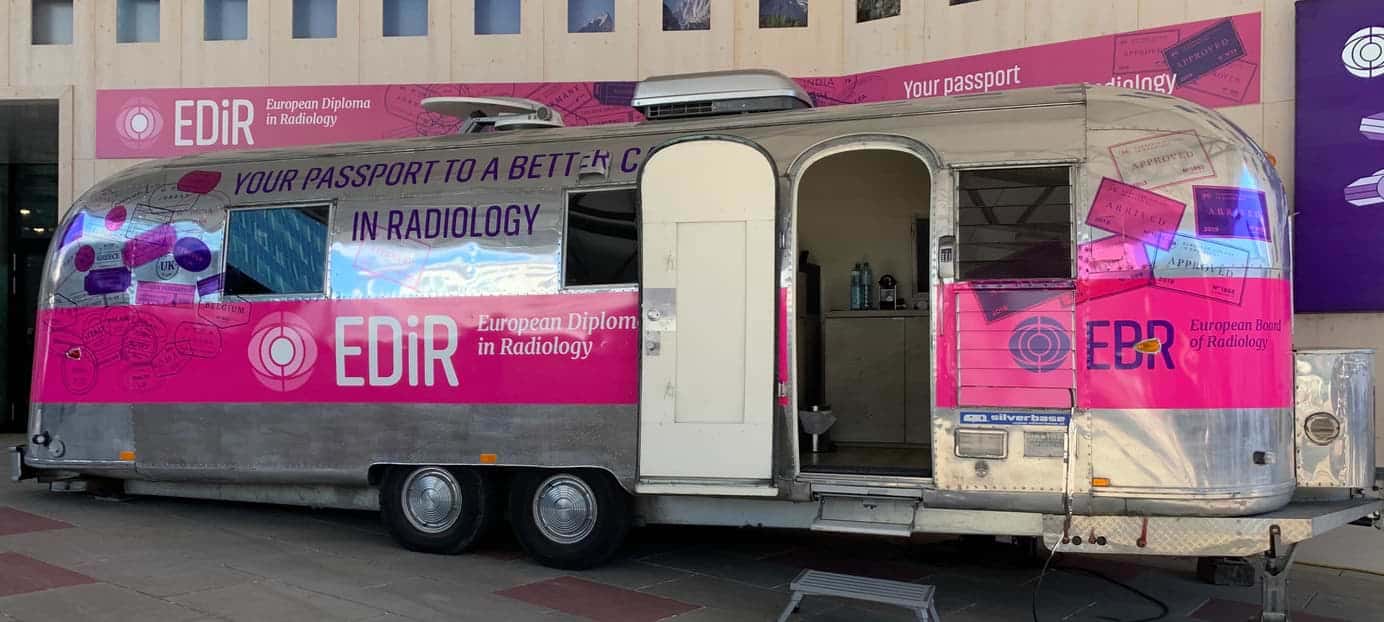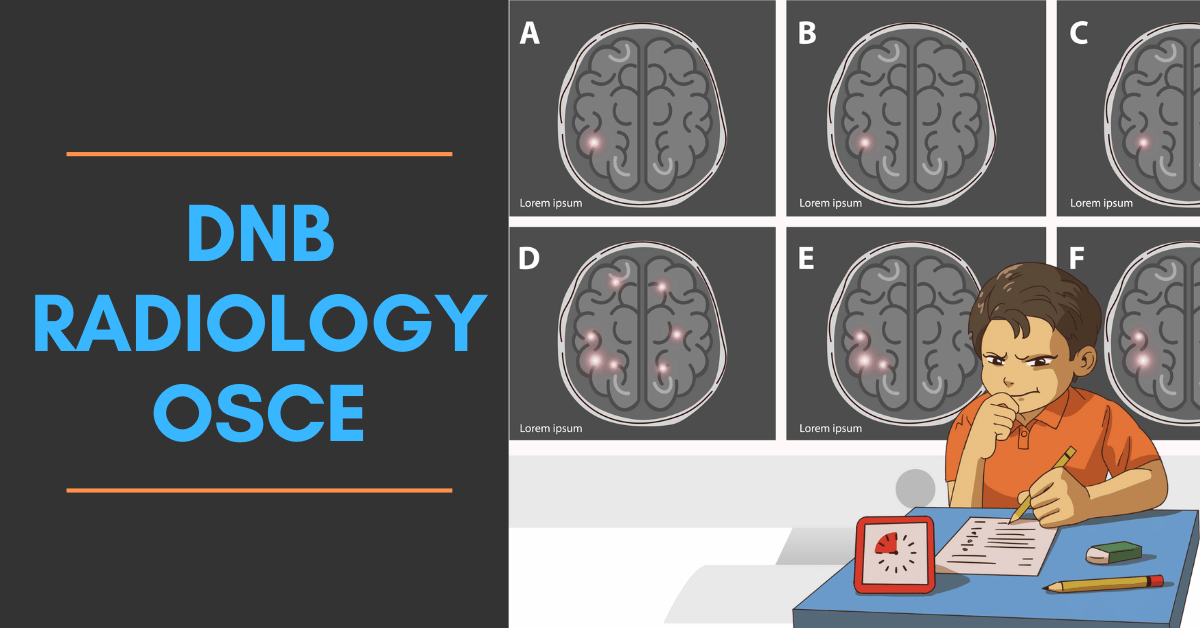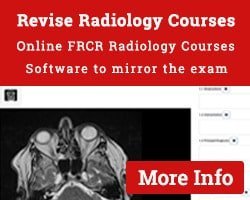
-
- Introduction
- What are the benefits of the EDiR?
- What is the EDiR exam structure?
- Where and when is the EDiR exam conducted?
- Eligibility for the EDiR exam
- Documentation required
- EDiR Exam fees
- Syllabus
- Useful online resources for EDiR exam
- Recommended Books for the EDiR exam
- Personal tips for the EDiR exam
- Video version of this post
- Tips from EDiR exam candidates
- BONUS – Quick revision before the exam
- ECR – All you need to know!
Introduction
What is EDiR?
EDiR stands for European Diploma in Radiology. This exam is conducted by the European Board of Radiology and the European Society of Radiology.
Here is a brief introductory video for the EDiR at ECR 2019:
What are the benefits of the EDiR?
- An international benchmark for general radiology and is officially and fully endorsed by the European Union of Medical Specialists (UEMS) and the ESR.
- The EDiR is recognized as an equivalent of the Polish exit training examination, the first part of the Turkish board examination and the image interpretation part of the Finnish national examination. Moreover, in order to practice radiology in The Netherlands, trainees must either pass their national board examination or the EDiR.
- Currently, with the EDiR degree, we cannot practice in European countries, however, once u clear the exam it indicates that you are satisfying the curriculum of European radiology training. EDiR is definitely an added value to the candidates’ CV, differentiating them from other contenders when applying for a job or fellowship.
- Check this video from ECR 2019 describing an EDiR holder’s experience (You need to signup. Don’t worry it’s free! )
What is the EDiR exam structure?
The examination tests knowledge, skills, and competence in general radiology in three parts :
- Multiple response questions (MCQs): Computer-based examination (90 minutes).
- Short cases (SCs): Computer-based examination (90 minutes).
- Clinically Oriented Reasoning Evaluation (CORE): Practical-oriented cases, computer-based examination (90 minutes).
You can refer to this explanatory webinar from the ECR 2019 for a brief description of the exam
Where and when is the EDiR exam conducted?
There are multiple exam centers for the exam, including New Delhi India, and Islamabad. An advantage of appearing for the EDiR exam during ECR at Vienna is that when we register for the exam, fees for the ECR congress are waived off. To avail of this, we need to register 4-5 months early for the examination.
Next EDiR dates:
The updated EDiR exam calendar can be accessed from the EDiR exam calendar page.
Eligibility for the EDiR exam:
- Candidates must at least be in their fifth year of national radiology training at the time of the examination.
- Active membership of the relevant national radiological society in the year of the examination is required.
- Candidates must be ESR full members, corresponding members or members in training in the year of the examination
Documentation required for the EDiR examination:
Below is the requested documentation during the online application process. There are direct links to download the proof templates. It is not necessary to use the templates provided, but all documents must be in English.
- A proof of training indicating the duration of radiology training and expected date of completion (if not completed) issued by the training institution. In case your training is complete we kindly ask you to send your Certificate of Completion of Training.
- In cases where the duration of the training programme is less than five years, proof of experience as a supervised staff radiologist is required.
- Proof of active membership of the relevant national radiological society.
- A scanned copy of your passport.
How to apply for the EDiR exam?
Applications can be made online from the EDiR exam calendar page: Apply for the EDiR online
What are the fees for the EDiR exam?
Here are the fees:
- €500 for full ESR members and ESR members in training.
- €1,100 for corresponding ESR members.
Make sure you through the terms and conditions for the exam before applying
The examination is conducted at the specified centers with 90 min of each session. The only part which I felt tough was the MRQs part which consumes a lot of time and few questions are a little tougher than expected especially in cardiac, breast and MSK imaging. Most of the short and long cases are those we routinely see in our daily practice. In the CORE exam part, they ask you to describe the findings seen and what could be the next step of management. The scoring part for the exam is a little complex and it is available on the website and you will be receiving an mail from them regarding the scoring system for each part.
What is the pass rate for the EDiR exam?
According to this publication by the European Board of Radiology, in 2017 the pass rate was approximately 70%.
What is the syllabus for the EDiR?
Quoting the same EBR paper:
- Knowledge, skills, and competence in anatomy, pathophysiology, imaging procedures, physics, and management in general radiology is tested.
- 13 categories are included in all examinations: abdominal, breast, cardiac, chest/thorax, head, and neck, imaging physics including radiation safety, imaging pharmacology including contrast media and radiopharmaceuticals, interventional and vascular, management, musculoskeletal, pediatrics, urogenital and neuroradiology.
- Check the distribution of each of these categories: EDiR category wise question distribution.
What do examiners expect at the EDiR from candidates?
EDiR Simulation Exam (Practical Exam Queries Answered)
https://www.youtube.com/watch?v=jNXpdFU46F4
Useful online resources for the EDiR exam:
- Sample exam questions for the EDiR:
EDiR Sample Examination
EDIR Bareceloma Preparatory Session:
Here are all the latest Webinars from the European Board of Radiology:
- Self-assessment tests for the EDiR exam: Each test module consists of 20 questions and is priced at €14.99
- EDiR - The Essential Guide – Now available!
- EDiR app
- EBR blog for cases
- European Training Curriculum of Radiology
Recommended books for EDiR exam from the official EDiR page:
This list is only for general guidance. All these are NOT NECESSARILY required to clear the examination.
General Radiology
- Brant WE and Helms CA (2012) Fundamentals of Diagnostic Radiology, 4th edition. Lippincott Williams & Wilkins. ISBN: 978-1608319121
- Rumack CM, Wilson SR, Charboneau JW and Levine D (2011) Diagnostic Ultrasound, 4th edition. Elsevier Mosby. ISBN: 978-0323053976
- Prokop M and Galanski M (2003) Spiral and Multislice Computed Tomography of the Body. Thieme. ISBN: 978-0865778702
- Reimer P, Parizel PM, Meaney JFM and Stichnoth FA (2010) Clinical MR Imaging: A Practical Approach. Springer. ISBN: 978-3540745013
- Huda W Review of Radiologic Physics
- Radiology Review Manual - Dahnert
- Grainger & Allison's Diagnostic Radiology
- Primer of Diagnostic Imaging
Breast Radiology
Cardiac Radiology
- Bogaert J, Dymarkowski S, Taylor AM and Muthurangu V (2012) Clinical Cardiac MRI (Medical Radiology), 2nd edition. Springer. ISBN: 978-3642230349
- Halpern EJ (2011) Clinical Cardiac CT: Anatomy and Function, 2nd edition. Thieme. ISBN: 978-1604063752
Chest Radiology
- Webb WR and Higgings CB (2010) Thoracic Imaging: Pulmonary and Cardiovascular Radiology, 2nd edition. Lippincott Williams & Wilkins. ISBN: 978-1605479767
- Reed JC (2010) Chest Radiology: Plain Film Patterns and Differential Diagnoses, Expert Consult, 6th edition. Elsevier Mosby. ISBN: 978-1437723458
Emergency Radiology
- Soto JA and Lucey BC (2009) Emergency Radiology: The Requisites. Elsevier Mosby. ISBN: 978-0323054072 OR
- Marincek B and Dondelinger RF (2011) Emergency Radiology: Imaging and Intervention. Springer. ISBN: 978-3642065682
Gastrointestinal and Abdominal Radiology
- Boland GW (2013) Gastrointestinal Imaging: The Requisites, 4th edition. Elsevier Saunders. ISBN: 978-0323101998.
- Hamm B, Krestin GP, Laniado M, Nicolas V and Taupitz M (2009) MR Imaging of the Abdomen and Pelvis. Thieme. ISBN: 978-3131455918
Head and Neck Radiology
Interventional Radiology
Musculoskeletal Radiology
- Resnick DL and Kransdorf MJ (2005) Bone and Joint Imaging, 3rd edition. Elsevier Saunders. ISBN: 978-0721602707
- Helms CA, Major NM, Anderson MW, Kaplan PA and Dussault R (2008) Musculoskeletal MRI, 2nd edition. Elsevier Saunders. ISBN: 978-1416055347
Neuroradiology
Pediatric Radiology
Urogenital Radiology
EDiR case reviews:
Tips for the EDiR exam by Dr. Venkatesh M:
- Strong and positive attitude towards the exam
- All the systems are covered almost in equal proportions
- MCQS section plays a major role in the exam passing criteria
- The theory part is especially useful to answer MCQs
- The toughest part for Residents is cardiac and Breast imaging cases as we have less exposure during residency.
- The 1st session is MCQS completely based on the theoretical aspect. 2nd and 3 rd sessions are completely practical oriented with good clinical knowledge assessment
- I would suggest all practice more case studies like which are available in Auntminnie, ACR case in point, AJNR Cases and FRCR practice cases.
- Short and long case sessions are usually common and classic cases with clinical history which is always a clue to narrow the differential diagnosis
- I suggest reading theory part 1-2 months before the exam.
- Physics MCQs are not more than 5-8 questions.
- Try to solve cases as much as possible
- Don’t worry about the spelling mistake as they are not considered while correcting.
- Radiogyan has a very good collection of spotters and cases which helps you a lot
- EDiR mobile app is available where they constantly post cases every week in all the systems
- EDiR app also has access to previous cases and discussion made by Dr. Prof Caceres
- EDiR is not as tough as FRCR. People who cleared FRCR can easily give this
Video version of the post:
I thank Dr. Amar Udare for giving me this opportunity to share my experience at EDiR and ECR. Kindly utilize the information provided and share it with our colleagues, seniors, and juniors. You can comment below or contact me if you have any questions: drvenkimdrd@rediffmail.com
All the best everyone!
Tips from EDiR exam candidates:
Here are a few tips from radiologists who have cleared the exam:
Dr Sam from India says:
- Crack the core -3 revisions-last revision 3days before the exam
- Consolidate your concepts from Grainger & Allison's Diagnostic Radiology and Haaga
- Recommended books
- Oral recalls with picture-based recalls from FRCR do it 2weeks before the exam
- For long cases solve questions from Hong Kong College of Radiologist case of the month series, do it after you have finished your theory revision
- Keep EDiR essential guide book as your mock exam tool, do it 5days before the exam
Other mock exam series are available in each specialty for 14 Euros each u can try this. - Aunt Minnie and ACR website has a case of the day /case in point series solve as much as possible
- Do report x-ray, CT and MRI on a daily basis in your department
- Euro-rad case of the day for long and short case.
- MRQs are the difficult part of the exam I solved few FRCR 2a MCQ books but after giving the exam I feel they test your core concepts so solving single best answers may not really help you in the exam…My associate professor failed in MRQS alone so don’t do guesswork during exam it’s better not to mark answers which you are not sure of.I believe MRQS are the deciding factor in passing the exam as most of us will get long and short cases correct
- If you are on the journey of FRCR it’s best advisable to give EDiR just after your 2a or 2b
- Revise contrast agents from the European Society of Urology and basic physics important topics on radiation safety and contrast allergy management.
- Do hybrid imaging revision from Crack the Core Exam - Volume 1 and Crack the Core Exam - Volume 2 more than enough to tackle 2 or 3 MRQs
Tip during exam:
- Time management for MRQs are crucial. If you are not sure of answers, skip it and u can solve it later
- Long and short cases will be easy except for 2 or 3 cases
- The DICOM viewer for long and short cases during the exam will be silky smooth you will not have any problem in changing windows or adjusting contrast
- They provide beverages and small snacks during your break so don’t worry about carrying lunch
- Overall a good exam. Do attempt it and don’t be afraid
Hope this helps!
Dr Rajesh Pahwa says:
1. Get orientated to give examination
- By attempting mock question papers available online. Most helpful as this simulate examination situation
- By going through EDIR book in details
- By attempting questions linked to Education on-demand credit CME in ESR my user area
- By subscribing to Esr connect system-wise lectures for the area one is weak.
2. Understand the examination well.
- Try to be specific in answering the question.
- Try to answer less than more options until you are 100% sure as your wrong response will take away the value of correct responses.
- In any case, they do not want you to achieve 100% marks. If you keep your self above 70% in all the questions on an average you will hit the average mean of rest of the candidates ( go through results of people who passed the examination)
- Try to give a pause before answering and then ticking the response.
- Try to manage time while answering the questions. Skip the questions that you are not confident and come back later ( this is very helpful also keeps you in a cool state of mind )
- Do not leave any question or case
- This examination is not testing your factual knowledge or knowledge something which one can assimilate in one or two months. Give yourself at least six months. Go slow.
Resources:
5. This examination is testing your observational, analytic, planning skills, basic radiology knowledge ( nothing more than Grainger and Allison radiology textbook), basics applied principles of basic physics radiation protection all imaging modalities.
Consider this as an opportunity to upgrade radiological knowledge and do well. Best of luck!
Dr. Ola Szubert says
1. MRQ —> CORE Radiology by Mandell, to be honest, each word is important, ESUR guidelines, Top 3 differential text. I think less is more – one/two answers are enough per question unless you are very very very very sure that you are right.
2. Short cases —> Top 3 Differential is absolutely the best – read it very carefully, close your eyes, try to think about the pathology you saw in other modalities, in other anatomical locations, after contrast administration, without, enhancement pattern. Don’t worry that you made a mistake – it is normal that during this part you feel really bad about your choices just keep clicking!
3. CORE —> the most difficult part, in my opinion, general rule: it is NOT important to diagnose, we are not pathomorphologist, it is crucial to write what you see and what you don’t see (both positive and negative findings are crucial). It is also important to use PARTICULAR words like Tuberculosis = tree in bud, GBM = transcallosal lesion, etc.
Check a few sample CORE cases shared by Dr. Ola here.
Dr Prateek Gandhi:
The best thing about EDiR is that you could give the exam only in your fifth year of Radiology Training and not sooner and as by this time you have already seen an exceedingly large number and variety of cases it helps immensely in the exam.
EDiR is by and large a much more clinic oriented exam than academics oriented.
To sum up, the pattern is MCQ on theory (which is the toughest part for any practising consultant), 25 short cases and 10 long cases.
They usually have a mixed bag of cases, I had coronary CT, MR Prostate, amongst all other usual CT and MRI, so having reported all modality and all cases in your residency helps.
Also, although they say there’s no negative marking but they are looking for a safe radiologist, and the marking scheme is designed in this way. So in the exam, mark only that option which you know for sure is the right one. Never guess. You mark both the right and wrong ones and you’ll get zero marks. You mark few right ones and leave the wrong ones, you’ll get some marks, and it is a very big deciding factor.
Also, X-ray reporting is something that most of us don’t do these days. So you could maybe spend more time giving finesse to your X-ray reading skills.
Lastly, the resources to read in the order I found important
- Dr Pepe EDiR blogs (most important resource)
- Thieme Radcases
- Aunt Minnie Website
- Revise spotter cases that you read for your board exam.
Quick Revision Slides before the EDiR exam
Disclaimer: Every effort has been undertaken to assure the authenticity of the information. However, the essence comes from the author’s personal experience. This is ONLY a guide to help you get basic information. Candidates are advised to check the EDiR website and the websites mentioned in the above post for the latest information. This website is not affiliated to the EDiR or EBR.






Very well written….
Thank you, Dr. Vineet. Glad you found it useful 🙂
Great buddy! This is very useful for aspirants interested in writing EDiR.
Thank you for your kind words
Glad you like it 🙂
Awesome work!
Thank you 🙂
Very informative and inspiring
Thank you for your kind words, Nusrat.